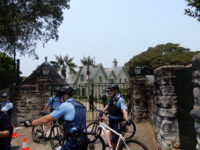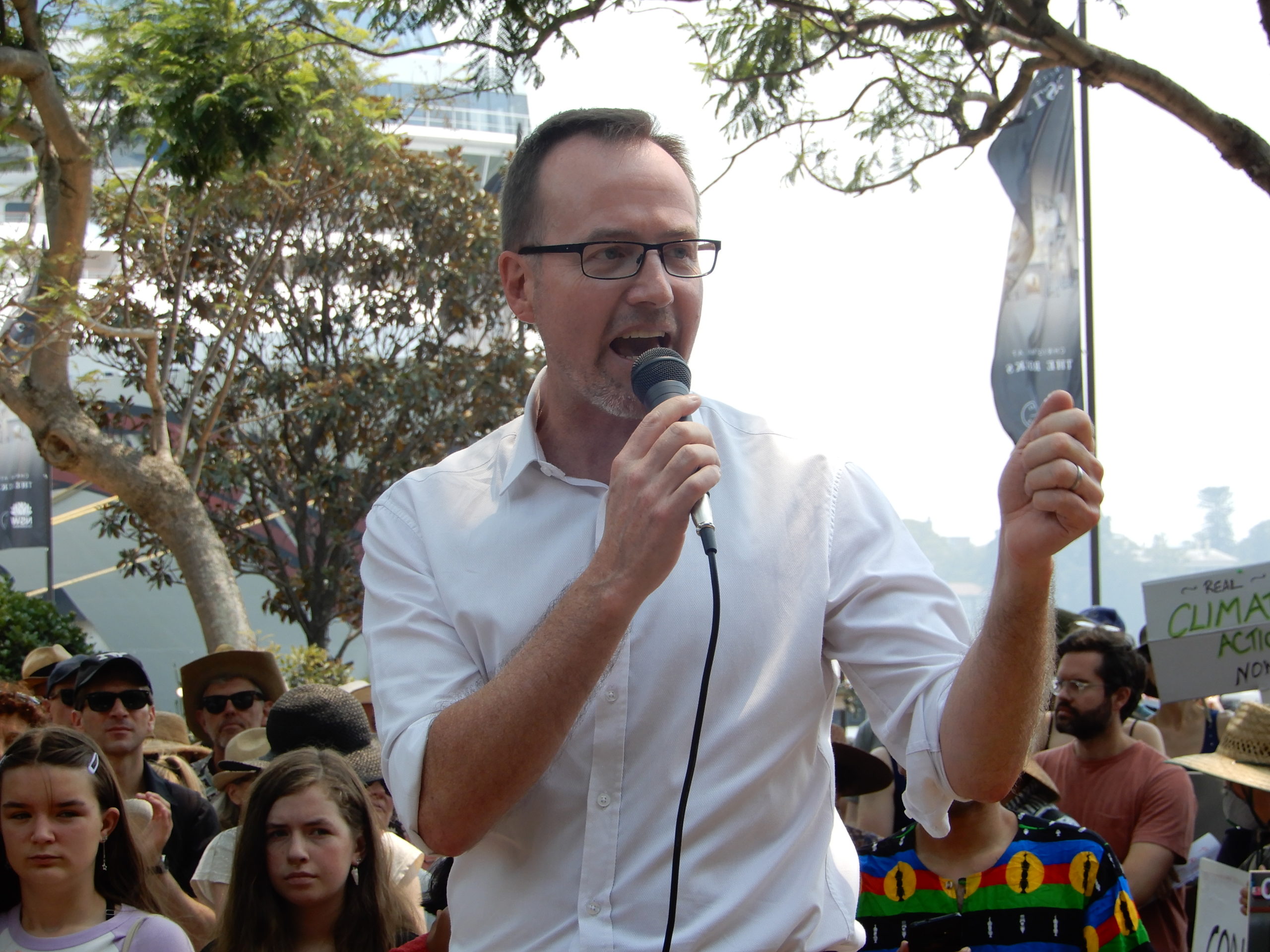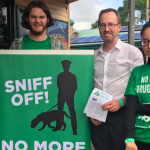Police Abuse Powers at Kirribilli: An Interview With Greens MLC David Shoebridge

As rumours circulated about the PM having perhaps taken off to Hawaii for a holiday with his family as a well set in nationwide bushfire crisis continued, hundreds of student climate activists gathered out front of Kirribilli House on 19 December, demanding leadership from an absent Scott Morrison.
Some of the activists set up tents announcing that they were going to wait out the front of the PM’s Sydney residence until he returned and dealt with the unprecedented fires, which have come on the back of his gaping lack of action on the climate emergency.
Faced with so many peaceful protesters calling on the government to take action – rather than continue on with its increasingly unviable climate change denying stance – state authorities responded in the only way they know how: using brute force.
As NSW Greens MLC David Shoebridge described, NSW police – including members of its Public Order and Riot Squad – descended upon the demonstrators exercising move on powers in a situation that they were never intended to be used in.
Normalising over-policing
Indeed, sending in the police and broadening their powers have been two key measures that governments in Australia have taken in direct response to the rising nonviolent climate actions that are taking place across the country.
In Queensland, the Palaszczuk government has responded to the rise by passing laws allowing for protesters using lock-on devices to be thrown in prison, while strip searching climate activists in the watchhouse is now common, and remanding protesters for nonviolent actions has begun.
Meanwhile, back in NSW, the Berejiklian government just passed the Right to Farm Bill that has little to do with agriculture, but much to do with silencing dissent. And this follows on the Coalition’s Crown land anti-protest laws of last year, as well as 2016’s trespass on inclosed land measures.
And as Shoebridge has been tracking, this beefing up of laws has been accompanied by an escalation in aggressive policing tactics. The Greens justice spokesperson has pointed to the widespread misapplication of sniffer dog use by NSW police, along with strip searches having become routine.
Moving them on
Mr Shoebridge was one of ten protesters arrested out the front Scott Morrison’s Kirribilli residence. The Greens MLC and the other arrestees were subsequently charged with failure to comply with a move on direction.
And later that Thursday afternoon, social media sites lit up with posts about 13-year-old Izzy Raj-Seppings who’d travelled with her father to the protest, only to be threatened with arrest by a senior constable, in such an aggressive manner that it brought the young girl to tears.
Sydney Criminal Lawyers spoke to David Shoebridge about why the use of move on powers that day was an overreach, what the arrest process was like, and how he posits that the climate movement is getting so large that soon the government will have to implement positive change.
Firstly, on 19 December, activists gathered out the front of the prime minister’s Kirribilli residence to protest his absence in the face of a national emergency.
Demonstrators had vowed to remain camped there until he returned to the country. But, they didn’t end up staying. David, why was that?
The NSW police, including the riot squad, came in and broke up the camp. They purported to use the move on powers that were extended in the last five years to break up the peaceful protest.
It was purely because police intervened and broke the camp up that the students had to disperse.
You were amongst ten protesters who were arrested on the day for failure to comply with move on orders. You’ve said that NSW police officers were abusing their powers at this point. Can you explain why?
The act of putting these move on powers on the statute books was opposed by the Greens, because we could see how they’d be abused.
The rationale given at the time by the Coalition – with the support of Labor – was that they were necessary to ensure public safety and that roadways weren’t blocked.
In this case, there was no public safety threat. And the only roadway that was blocked was a 20-metre-deep cul-de-sac.
No one was blocking the access to Kirribilli House. And pedestrians could easily move through the students if they wanted to access the path behind. So, there was no valid reason for the police to exercise the move on powers.
In fact, I urged them not to do it on the day, because the only thing the use of the move on powers was likely to do was escalate a peaceful, non-disruptive protest into an ugly scene.
So, how would you describe the arrest experience for you and the other arrestees? What did it involve? And will there be any further proceedings related to the incident?
The police had obviously come prepared to break up the protest regardless. They had established a mass arrest processing facility underneath the Harbour Bridge to deal with these school kids.
They sent in at least 30 of the riot squad, who actually formed in military ranks of about four deep and gave a loud, aggressive series of grunts, before moving in to break up the protests.
If you see any videos from the day, particularly those involving police surrounding school kids and issuing move on orders, it was all clearly designed to intimidate and, in part, that worked.
With my arrest, I had every intention of complying. I was in the middle of advising police that I would comply with their move on orders, because the students themselves had decided to do so.
But, I wasn’t allowed to finish my sentence. And I was arbitrarily grabbed and arrested by the riot squad.
The arrest itself was fairly standard procedure. Without my consent, they searched me, removed my belt, stuck me in the back of a police wagon and drove me to under the bridge, where they held me for about 20 minutes in the back of the wagon with two other detainees.
They then brought down two detectives from Chatswood police station to take my statement. The entire thing was a ridiculous waste of police resources.
Once they took my statement – which was in a very brief form – they issued me with a court attendance notice, having charged me with failure to comply with a move on direction. And I’ll be in Manly Court on 16 January.
There was also footage of a NSW police senior constable delivering move on orders to a clearly frightened young girl, who was brought to tears. And despite this, the officer continued on with his arrest threats. What did you think about that scenario?
This wasn’t a case of just one officer confronting a 13-year-old girl. He had a pack of riot squad police surrounding him and the young girl in question.
She was always going to comply with the move on order. She didn’t require intimidation in addition to the direction. But, that’s what she got, courtesy of the NSW police.
This is a pretty clear case of police abusing their powers, and intimidating school kids.
David, the intensity of the climate movement has been growing over the last year, yet the response of authorities has been to crackdown harder with reinforced laws and tougher policing. Can you talk on this?
We’ve seen a pretty clear set of political steps from the Coalition government. They’ve refused to take action on climate and continued to back an expanded coal industry.
Then their key public sector resourcing response has been to increase police powers, as well as increase the number of police by 1,500 additional officers. And that’s just the commitment going forward over the next three years.
Rather than address the root cause of public unrest, which would be to tackle climate change and bringing to heel the fossil fuel industries, this government has decided that they’d tackle the public, increase police, increase police powers and try to arrest their way out of an emergency.
And given what you’ve just said, how long do you think governments of the Berejiklian and Morrison ilk can simply continue to use force to deny there’s a climate crisis?
Force can be used to arrest one MP, or a dozen protesters, but we saw just before Christmas, 40,000 Sydneysiders willing to come out to a snap rally to demand action.
Once you start getting protests of those numbers, our existing legal infrastructure – even the ramped-up police powers and police force – will be unable to cope.
The only effective response to a mass mobilisation demanding climate action will be policy change.
But, in the meantime, we’re going to see more arrests, more abuse of police powers and we’re going to see an increasingly illegitimate state and federal government.








